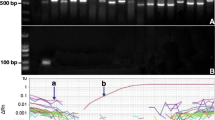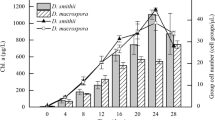Abstract
Freshwater algal blooms have become a growing concern world-wide. They are caused by a high level of cyanobacteria, predominantly Microcystis spp. and Cylindrospermopsis raciborskii, which can produce microcystin and cylindrospermopsin, respectively. Longtime exposure to these cyanotoxins may affect public health, thus reliable detection, quantification, and enumeration of these harmful algae species has become a priority in water quality management. Traditional manual enumeration of algal bloom cells primarily involves microscopic identification which limited by inaccuracy and time-consumption.With the development of molecular techniques and an increasing number of microbial sequences available in the Genbank database, the use of molecular methods can be used for more rapid, reliable, and accurate detection and quantification. In this study, multiplex polymerase chain reaction (PCR) and real-time quantitative PCR (qPCR) techniques were developed and applied for monitoring cyanobacteria Microcystis spp. and C. raciborskii in the Macau Storage Reservoir (MSR). The results showed that the techniques were successful for identifying and quantifying the species in pure cultures and mixed cultures, and proved to be a potential application for water sampling in MSR. When the target species were above 1 million cells/L, similar cell numbers estimated by microscopic enumeration and qPCR were obtained. Further quantification in water samples indicated that the ratio of the estimated number of cell by microscopy and qPCR was 0.4–12.9 for cyanobacteria and 0.2–3.9 for C. raciborskii. However, Microcystis spp. was not observed by manual enumeration, while it was detected at low levels by qPCR, suggesting that qPCR is more sensitive and accurate. Thus the molecular approaches provide an additional reliable monitoring option to traditional microscopic enumeration for the ecosystems monitoring program.
Similar content being viewed by others
References
Al-Tebrineh J, Pearson L A, Yasar S A, Neilan B A (2012). A multiplex qPCR targeting hepato- and neurotoxigenic cyanobacteria of global significance. Harmful Algae, 15: 19–25
Alster A, Kaplan-Levy R N, Sukenik A, Zohary T (2010). Morphology and phylogeny of a non-toxic invasive Cylindrospermopsis raciborskii from a Mediterranean Lake. Hydrobiologia, 639(1): 115–128
Artz R R E, Avery L M, Jones D L, Killham K (2006). Potential pitfalls in the quantitative molecular detection of Escherichia coli O157:H7 in environmental matrices. Can J Microbiol, 52(5): 482–488
Falconer I, Bartram J, Chorus I, Kuiper-Goodman T, Utkilen H, Burch M, Codd G A (1999). Safe levels and safe practices. In: Chorus I, Bartram J eds. Toxic Cyanobacteria inWater, A Guide to Their Public Health Consequences, Monitoring and Management. London: Spon Press, 161–182
Felske A, Osborn A M (2005). DNA fingerprinting of microbial communities. In: Osborn A M, Smith C J eds. Molecular Microbial Ecology. New York: Taylor & Francis, 65–90
Giglio S, Monis P T, Saint C P (2003). Demonstration of preferential binding of SYBR Green I to specific DNA fragments in real-time multiplex PCR. Nucleic Acids Res, 31(22): e136
Ha J H, Hidaka T, Tsuno H (2009). Quantification of toxic Microcystis and evaluation of its dominance ratio in blooms using real-time PCR. Environ Sci Technol, 43(3): 812–818
Hawkins P R, Chandrasena N R, Jones G J, Humpage A R, Falconer I R (1997). Isolation and toxicity of Cylindrospermopsis raciborskii from an ornamental lake. Toxicon, 35(3): 341–346
Humbert J F, Quiblier C, Gugger M (2010). Molecular approaches for monitoring potentially toxic marine and freshwater phytoplankton species. Anal Bioanal Chem, 397(5): 1723–1732
Kurmayer R, Kutzenberger T (2003). Application of real-time PCR for quantification of microcystin genotypes in a population of the toxic cyanobacterium Microcystis sp. Appl Environ Microbiol, 69(11): 6723–6730
Larionov A, Krause A, Miller W (2005). A standard curve based method for relative real time PCR data processing. BMC Bioinformatics, 6(1): 62
McAlice B J (1971). Phytoplankton sampling with the Sedgewick Rafter Cell. Limnol Oceanogr, 16(1): 19–28
Moreira C, Martins A, Azevedo J, Freitas M, Regueiras A, Vale M, Antunes A, Vasconcelos V (2011). Application of real-time PCR in the assessment of the toxic cyanobacterium Cylindrospermopsis raciborskii abundance and toxicological potential. Appl Microbiol Biotechnol, 92(1): 189–197
Nübel U, Garcia-Pichel F, Muyzer G (1997). PCR primers to amplify 16S rRNA genes from cyanobacteria. Appl Environ Microbiol, 63(8): 3327–3332
Oh K H, Jeong D H, Shin S H, Cho Y C (2012). Simultaneous quantification of cyanobacteria and Microcystis spp. using real-time PCR. J Microbiol Biotechnol, 22(2): 248–255
Ohtani I, Moore R E, Runnegar M T C (1992). Cylindrospermopsin: a potent hepatotoxin from the blue-green alga Cylindrospermopsis raciborskii. J Am Chem Soc, 114(20): 7941–7942
Orr P T, Rasmussen J P, Burford M A, Geoffrey E K, Eaglesham G K, Lennox S M (2010). Evaluation of quantitative real-time PCR to characterise spatial and temporal variations in cyanobacteria, Cylindrospermopsis raciborskii (Woloszynska) Seenaya et Subba Raju and cylindrospermopsin concentrations in three subtropical Australian reservoirs. Harmful Algae, 9(3): 243–254
Otsuka S, Suda S, Li R, Watanabe M, Oyaizu H, Matsumoto S, Watanabe M M (1998). 16S rDNA sequences and phylogenetic analyses of Microcystis strains with and without phycoerythrin. FEMS Microbiol Lett, 164(1): 119–124
Paerl H W, Huisman J (2009). Climate change: a catalyst for global expansion of harmful cyanobacterial blooms. Environ Microbiol Rep, 1(1): 27–37
Pearson L A, Neilan B A (2008). The molecular genetics of cyanobacterial toxicity as a basis for monitoring water quality and public health risk. Curr Opin Biotechnol, 19(3): 281–288
Pidasak J (1997). Cylindrospermopsis raciborskii (Woloszynska) Seenayya et Subba Raju, an expanding highly adaptive cyanobacterium: worldwide distribution and review of its ecology. Arch Hydrobiol, 107(Supplement): 563–593
Rasmussen J P, Giglio S, Monis P T, Campbell R J, Saint C P (2008). Development and field testing of a real-time PCR assay for cylindrospermopsin-producing cyanobacteria. J Appl Microbiol, 104(5): 1503–1515
Rinta-Kanto J M, Ouellette A J A, Boyer G L, Twiss M R, Bridgeman T B, Wilhelm S W (2005). Quantification of toxic Microcystis spp. during the 2003 and 2004 blooms in western Lake Erie using quantitative real-time PCR. Environ Sci Technol, 39(11): 4198–4205
Scholin C A, Herzog M, Sogin M, Anderson D M (1994). Identification of group- and strain-specific genetic markers for globally distributed Alexandrium (Dinophyceae). II. Sequence analysis of a fragment of the LSU rRNA gene. J Phycol, 30: 999–1011
Schoske R, Vallone P M, Ruitberg C M, Butler J M (2003). Multiplex PCR design strategy used for the simultaneous amplification of 10 Y chromosome short tandem repeat (STR) loci. Anal Bioanal Chem, 375(3): 333–343
Tomioka N, Nagai T, Kawasaki T, Imai A, Matsushige K, Kohata K (2008). Quantification of microcystis in a eutrophic lake by simple DNA extraction and SYBR green real-time PCR. Microbes Environ, 23(4): 306–312
Vaitomaa J, Rantala A, Halinen K, Rouhiainen L, Tallberg P, Mokelke L, Sivonen K (2003). Quantitative real-time PCR for determination of microcystin synthetase E copy numbers for microcystis and anabaena in lakes. Appl Environ Microbiol, 69(12): 7289–7297
WHO (1998). Guidelines for Drinking-Water Quality (2nd ed). Addendum to Vol 2, Health Criteria and Other Supporting Information. Geneva: World Health Organisation
Wilson K M, Schembri M A, Baker P D, Saint C P (2000). Molecular characterization of the toxic cyanobacterium Cylindrospermopsis raciborskii and design of a species-specific PCR. Appl Environ Microbiol, 66(1): 332–338
Wittwer C T, Herrmann M G, Moss A A, Rasmussen R P (1997). Continuous fluorescence monitoring of rapid cycle DNA amplification. Biotechniques, 22(1): 130–131, 134–138
Zhang W, Lou I, Kong Y, Ung W K, Mok K M (2013). Eutrophication analyses and principle component regression for two subtropical storage reservoirs in Macau. Desalination and Water Treatment, 51(37–39): 7331–7340
Author information
Authors and Affiliations
Corresponding author
Rights and permissions
About this article
Cite this article
Zhang, W., Lou, I., Ung, W.K. et al. Application of PCR and real-time PCR for monitoring cyanobacteria, Microcystis spp. and Cylindrospermopsis raciborskii in Macau freshwater reservoir. Front. Earth Sci. 8, 291–301 (2014). https://doi.org/10.1007/s11707-013-0409-4
Received:
Accepted:
Published:
Issue Date:
DOI: https://doi.org/10.1007/s11707-013-0409-4




